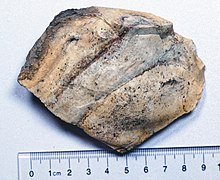
Back Vuursteen Afrikaans Pedrenya AN चकमक ANP صوان (حجر) Arabic Xil AST Çaxmaqdaşı Azerbaijani چاخماق AZB Саҡматаш Bashkir Tėtnagos BAT-SMG Крэмень Byelorussian
| Sedimentary rock | |
 A sample of Miorcani flint from the Cenomanian chalky marl layer of the Moldavian Plateau (c. 7.5 cm (3.0 in) wide) | |
| Composition | |
|---|---|
| Cryptocrystalline quartz |

Flint, occasionally flintstone, is a sedimentary cryptocrystalline form of the mineral quartz,[1][2] categorized as the variety of chert that occurs in chalk or marly limestone. Historically, flint was widely used to make stone tools and start fires.
Flint occurs chiefly as nodules and masses in sedimentary rocks, such as chalks and limestones.[3][4] Inside the nodule, flint is usually dark grey or black, green, white, or brown in colour, and has a glassy or waxy appearance. A thin, oxidised layer on the outside of the nodules is usually different in colour, typically white and rough in texture. The nodules can often be found along streams and beaches.
Flint breaks and chips into sharp-edged pieces, making it useful in constructing a variety of cutting tools, such as knife blades and scrapers. The use of flint to make stone tools dates back more than three million years; flint's extreme durability has made it possible to accurately date its use over this time. Flint is one of the primary materials used to define the Stone Age.
The examples and perspective in this section may not represent a worldwide view of the subject. (October 2023) |
During the Stone Age, access to flint was so important for survival that people would travel or trade long distances to obtain the stone. Grime's Graves was an important source of flint traded across Europe. Flint Ridge in Ohio was another important source of flint, and Native Americans extracted the flint from hundreds of quarries along the ridge. This "Ohio Flint" was traded across the eastern United States, and has been found as far west as the Rocky Mountains and south around the Gulf of Mexico.[5]
When struck against steel, flint will produce enough sparks to ignite a fire with the correct tinder, or gunpowder used in weapons, namely the flintlock firing mechanism. Although it has been superseded in these uses by different processes (the percussion cap), or materials (ferrocerium), "flint" has lent its name as generic term for a fire starter.
- ^ General Quartz Information, WebMineral.com. "Quartz Mineral Data". Archived from the original on 11 February 2021. Retrieved 4 March 2022.
{{cite web}}: CS1 maint: bot: original URL status unknown (link) (page contains java applets depicting 3D molecular structure) - ^ "Flint and Chert". quartzpage.de. Archived from the original on 12 January 2018. Retrieved 30 March 2008.
- ^ The Flints from Portsdown Hill Archived 13 November 2007 at the Wayback Machine
- ^ Flint vs Chert Authentic Artefacts Collectors Assn. Archived 17 August 2004 at the Wayback Machine
- ^ "Uses of Flint - Tools, weapons, fire starters, gemstones". geology.com. Archived from the original on 27 November 2020. Retrieved 26 March 2019.